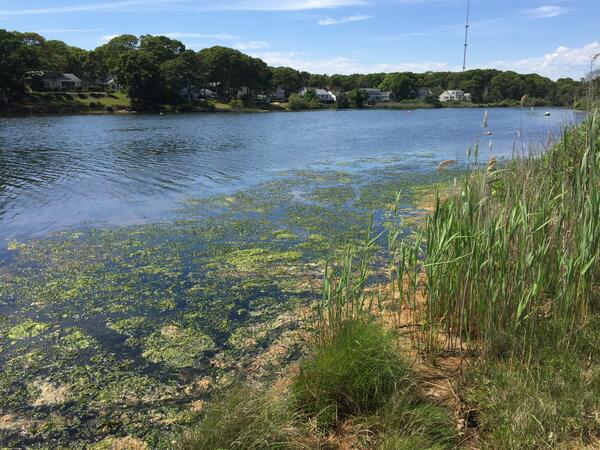New Studies Inform Management of Groundwater Nitrogen from Wastewater on Cape Cod
The U.S. Geological Survey (USGS) has conducted two new studies examining the presence and persistence of wastewater-derived nitrogen in Cape Cod's groundwater.
The research looked at nitrogen reduction based on both natural processes and human intervention. While nitrogen is a natural part of aquatic ecosystems, too much nitrogen can degrade water quality by increasing algal blooms and the growth of nuisance vegetation.
The first study, led by former USGS Hydrologists John Colman and Tom Huntington, sought to better understand the fate and transport of groundwater nitrogen at its discharge point to a coastal estuary. The second study, led by the U.S. Environmental Protection Agency (EPA) Office of Research and Development, evaluated the efficacy of newly installed alternative septic systems designed to remove significantly more nitrogen than conventional septic tanks.
Cape Cod homes predominately use onsite wastewater treatment systems, largely in the form of conventional septic systems and cesspools, to treat wastewater. These onsite wastewater treatment systems remove bacteria from wastewater, but do not effectively remove nitrogen – sending treated wastewater containing nitrogen back into the soil and groundwater. In coastal areas, groundwater transports nutrients and co-pollutants in wastewater to receiving surface waters, where excess nutrients can overload estuaries and embayments. Consequently, onsite wastewater treatment systems are considered a major contributor of excess nitrogen in the coastal waters of Cape Cod.
Investigating Groundwater Nitrogen Dynamics
In the densely developed Seacoast Shores peninsula in East Falmouth, Massachusetts, USGS scientists found that a significant amount of nitrogen was being transported by groundwater, but the concentrations of nitrogen significantly varied as it interacted with both fresh and saltwater. The mixing of freshwater and seawater underground in coastal aquifers is called a subterranean estuary.
Understanding the nitrogen dynamics in the subterranean estuary is an important consideration for estimating nitrogen loading when developing nitrogen management strategies. In the subterranean estuary near Seacoast Shores, USGS scientists observed that some groundwater nitrate was converted to nitrogen gas by microorganisms under different settings and geochemical conditions. Nitrogen in groundwater near the shoreline showed evidence of denitrification, resulting in less nitrogen entering the estuary of Eel Pond.
Drastic Reduction in Nitrogen Loading with New Wastewater Systems
The second recently published study by EPA-ORD, in cooperation with USGS, found that replacing traditional septic systems with innovative/alternative (IA) onsite wastewater treatment systems that use woodchip bioreactors reduced nitrogen loading by more than 90%. Scientists monitored nitrogen loading at 14 homes in Barnstable, Massachusetts before and after converting to the IA systems. The new systems hit their target concentration of less than 10 milligrams per liter of total nitrogen present in the treated wastewater. These findings demonstrate how effective these alternative systems are at reducing nutrient pollution and serve as a viable option for communities facing similar pollution issues associated with wastewater management.
The results from this research help natural resource scientists and managers better understand the presence and transport of nitrogen in Cape Cod’s coastal groundwater system, so that best nitrogen mitigation approaches can be applied.


